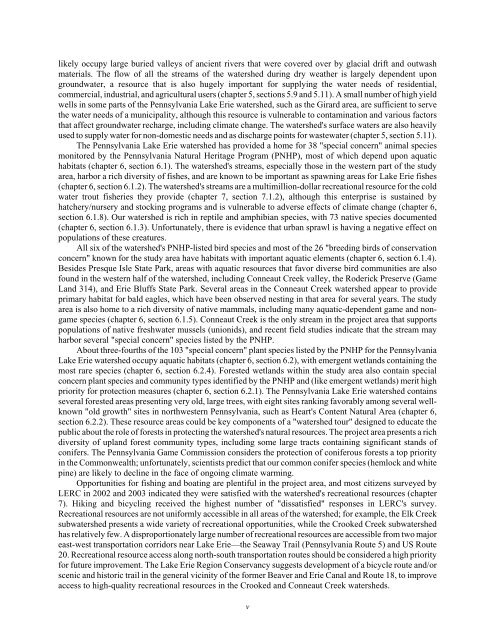Watershed Conservation Plan - Destination Erie
Watershed Conservation Plan - Destination Erie
Watershed Conservation Plan - Destination Erie
You also want an ePaper? Increase the reach of your titles
YUMPU automatically turns print PDFs into web optimized ePapers that Google loves.
likely occupy large buried valleys of ancient rivers that were covered over by glacial drift and outwash<br />
materials. The flow of all the streams of the watershed during dry weather is largely dependent upon<br />
groundwater, a resource that is also hugely important for supplying the water needs of residential,<br />
commercial, industrial, and agricultural users (chapter 5, sections 5.9 and 5.11). A small number of high yield<br />
wells in some parts of the Pennsylvania Lake <strong>Erie</strong> watershed, such as the Girard area, are sufficient to serve<br />
the water needs of a municipality, although this resource is vulnerable to contamination and various factors<br />
that affect groundwater recharge, including climate change. The watershed's surface waters are also heavily<br />
used to supply water for non-domestic needs and as discharge points for wastewater (chapter 5, section 5.11).<br />
The Pennsylvania Lake <strong>Erie</strong> watershed has provided a home for 38 "special concern" animal species<br />
monitored by the Pennsylvania Natural Heritage Program (PNHP), most of which depend upon aquatic<br />
habitats (chapter 6, section 6.1). The watershed's streams, especially those in the western part of the study<br />
area, harbor a rich diversity of fishes, and are known to be important as spawning areas for Lake <strong>Erie</strong> fishes<br />
(chapter 6, section 6.1.2). The watershed's streams are a multimillion-dollar recreational resource for the cold<br />
water trout fisheries they provide (chapter 7, section 7.1.2), although this enterprise is sustained by<br />
hatchery/nursery and stocking programs and is vulnerable to adverse effects of climate change (chapter 6,<br />
section 6.1.8). Our watershed is rich in reptile and amphibian species, with 73 native species documented<br />
(chapter 6, section 6.1.3). Unfortunately, there is evidence that urban sprawl is having a negative effect on<br />
populations of these creatures.<br />
All six of the watershed's PNHP-listed bird species and most of the 26 "breeding birds of conservation<br />
concern" known for the study area have habitats with important aquatic elements (chapter 6, section 6.1.4).<br />
Besides Presque Isle State Park, areas with aquatic resources that favor diverse bird communities are also<br />
found in the western half of the watershed, including Conneaut Creek valley, the Roderick Preserve (Game<br />
Land 314), and <strong>Erie</strong> Bluffs State Park. Several areas in the Conneaut Creek watershed appear to provide<br />
primary habitat for bald eagles, which have been observed nesting in that area for several years. The study<br />
area is also home to a rich diversity of native mammals, including many aquatic-dependent game and nongame<br />
species (chapter 6, section 6.1.5). Conneaut Creek is the only stream in the project area that supports<br />
populations of native freshwater mussels (unionids), and recent field studies indicate that the stream may<br />
harbor several "special concern" species listed by the PNHP.<br />
About three-fourths of the 103 "special concern" plant species listed by the PNHP for the Pennsylvania<br />
Lake <strong>Erie</strong> watershed occupy aquatic habitats (chapter 6, section 6.2), with emergent wetlands containing the<br />
most rare species (chapter 6, section 6.2.4). Forested wetlands within the study area also contain special<br />
concern plant species and community types identified by the PNHP and (like emergent wetlands) merit high<br />
priority for protection measures (chapter 6, section 6.2.1). The Pennsylvania Lake <strong>Erie</strong> watershed contains<br />
several forested areas presenting very old, large trees, with eight sites ranking favorably among several wellknown<br />
"old growth" sites in northwestern Pennsylvania, such as Heart's Content Natural Area (chapter 6,<br />
section 6.2.2). These resource areas could be key components of a "watershed tour" designed to educate the<br />
public about the role of forests in protecting the watershed's natural resources. The project area presents a rich<br />
diversity of upland forest community types, including some large tracts containing significant stands of<br />
conifers. The Pennsylvania Game Commission considers the protection of coniferous forests a top priority<br />
in the Commonwealth; unfortunately, scientists predict that our common conifer species (hemlock and white<br />
pine) are likely to decline in the face of ongoing climate warming.<br />
Opportunities for fishing and boating are plentiful in the project area, and most citizens surveyed by<br />
LERC in 2002 and 2003 indicated they were satisfied with the watershed's recreational resources (chapter<br />
7). Hiking and bicycling received the highest number of "dissatisfied" responses in LERC's survey.<br />
Recreational resources are not uniformly accessible in all areas of the watershed; for example, the Elk Creek<br />
subwatershed presents a wide variety of recreational opportunities, while the Crooked Creek subwatershed<br />
has relatively few. A disproportionately large number of recreational resources are accessible from two major<br />
east-west transportation corridors near Lake <strong>Erie</strong>—the Seaway Trail (Pennsylvania Route 5) and US Route<br />
20. Recreational resource access along north-south transportation routes should be considered a high priority<br />
for future improvement. The Lake <strong>Erie</strong> Region Conservancy suggests development of a bicycle route and/or<br />
scenic and historic trail in the general vicinity of the former Beaver and <strong>Erie</strong> Canal and Route 18, to improve<br />
access to high-quality recreational resources in the Crooked and Conneaut Creek watersheds.<br />
v





